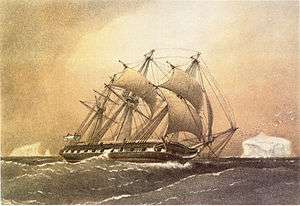HMS Challenger (1858)
HMS Challenger was a steam-assisted Royal Navy Pearl-class corvette launched on 13 February 1858 at the Woolwich Dockyard. She was the flagship of the Australia Station between 1866 and 1870.[2]
 Painting of Challenger by William Frederick Mitchell | |
| History | |
|---|---|
| Name: | HMS Challenger |
| Builder: | Woolwich Dockyard |
| Launched: | 13 February 1858 |
| Decommissioned: | Chatham Dockyard, 1878 |
| Fate: | Broken for scrap, 1921 |
| General characteristics | |
| Class and type: | Pearl-class corvette |
| Displacement: | 2,137 long tons (2,171 t)[1] |
| Tons burthen: | 1465 bm[1] |
| Length: |
|
| Beam: | 40 ft 4 in (12.29 m) |
| Draught: |
|
| Depth of hold: | 23 ft 11 in (7.29 m) |
| Installed power: |
|
| Propulsion: |
|
| Sail plan: | Full-rigged ship |
| Speed: | 10.7 knots (19.8 km/h) (under steam) |
| Armament: |
|
As part of the North America and West Indies Station she took part in 1862 in operations during the Second French intervention in Mexico, including the occupation of Veracruz. Assigned as the flagship of Australia Station in 1866 and in 1868 undertook a punitive operation against Fiji to avenge the murders of a missionary and some of his dependents. She left the Australian Station in late 1870.[2]
She was picked to undertake the first global marine research expedition: the Challenger expedition. The Challenger carried a complement of 243 officers, scientists and crew when she embarked on her 68,890-nautical-mile (127,580 km) journey.
The United States Space Shuttle Challenger was named after the ship.[3] Her figurehead is on display in the foyer of the National Oceanography Centre, Southampton.
1873–1876: Grand tour
The Challenger Expedition was a grand tour of the world covering 68,000 nautical miles (125,936 km) organized by the Royal Society in collaboration with the University of Edinburgh. Charles Thomson was the leader of a large scientific team.[4]
- Captains: George Nares (1873 and 1874) and Charles Wyville Thomson (1875 and 1876)
- Naturalists: Charles Wyville Thomson (1830–1882), Henry Nottidge Moseley (1844–1891) and Rudolf von Willemoes-Suhm (1847–1875)
- Oceanographers: John Young Buchanan (1844–1925) and John Murray (1841–1914)
- Publications: C.W. Thomson, Report on the scientific results of the voyage of HMS Challenger during the years 1873-76... prepared under the superintendence of the late Sir C. Wyville Thomson,... and now of John Murray,... (fifty volumes, London, 1880–1895). H.N. Moseley, Notes by a naturalist on the Challenger (1879). W.J.J. Spry, The cruise of the Challenger (1876).
To enable her to probe the depths, all but two of Challenger's guns had been removed and her spars reduced to make more space available.[5] Laboratories, extra cabins and a special dredging platform were installed. She was loaded with specimen jars, alcohol for preservation of samples, microscopes and chemical apparatus, trawls and dredges, thermometers and water sampling bottles, sounding leads and devices to collect sediment from the sea bed and great lengths of rope with which to suspend the equipment into the ocean depths.[6] In all she was supplied with 181 miles (291 km) of Italian hemp for sounding, trawling and dredging.[7]
The Challenger's crew was the first to sound the deepest part of the ocean, thereafter named the Challenger Deep.
Later service history
She was commissioned as a Coast Guard and Royal Naval Reserve training ship at Harwich in July 1876.[2]
In 1878 Challenger went through an overhaul by the Chief Constructor at Chatham Dockyard with a view to converting the vessel into a training ship for boys of the Royal Navy. She was found suitable and it was planned to take the place of HMS Eurydice which sank off the Isle of Wight on 24 March 1878.[8] The Admiralty did not go ahead with the conversion and she remained in reserve until 1883, when she was converted into a receiving hulk in the River Medway, where she stayed until she was sold to J B Garnham on 6 January 1921 and broken up for her copper bottom in 1921.[2]
Nothing, apart from her figurehead, now remains. This is kept at the National Oceanography Centre, Southampton.[9]
References
- Winfield (2004) p.209
- Bastock, pp.47-48.
- Space Shuttle Challenger at the Kennedy Space Centre website Archived 2009-02-03 at the Wayback Machine.
- The Voyage of H.M.S. Challenger 1873-1876. Narrative Vol. I. First Part. Chapter I, p. 19-20
- Bishop, Tina. "Then and Now: The HMS Challenger Expedition and the "Mountains in the Sea" Expedition". oceanexplorer.noaa.gov. NOAA. Retrieved 31 January 2018.
- "Scientific Equipment on HMS Challenger". HMS Challenger Project. 2 June 2015. Retrieved 31 January 2018.
- Sea Frontiers. 18. International Oceanographic Foundation. 1972.
- "Naval". The Cornishman (27). 16 January 1879. p. 6.
- "HMS Challenger". Figureheads. Royal Museums Greenwich. Retrieved 19 December 2018.
- Bastock, John (1988), Ships on the Au Station, Child & Associates Publishing Pty Ltd; Frenchs Forest, Australia. ISBN 0-86777-348-0
- Winfield, R.; Lyon, D. (2004). The Sail and Steam Navy List: All the Ships of the Royal Navy 1815–1889. London: Chatham Publishing. ISBN 978-1-86176-032-6.
External links
